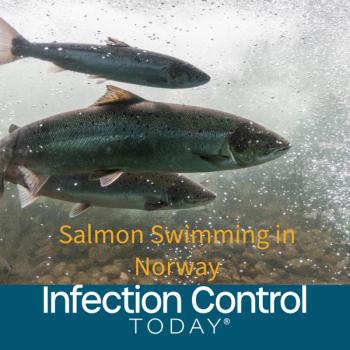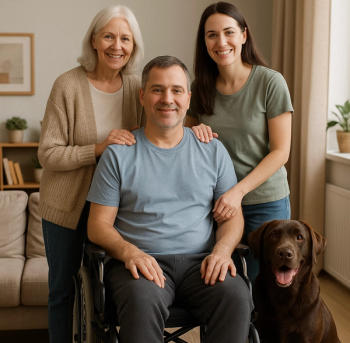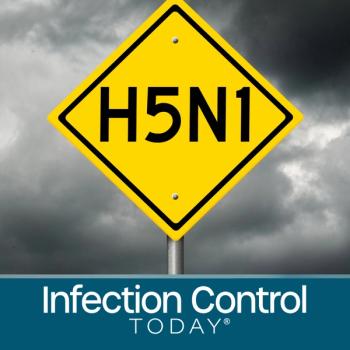
Contact Transmission of SARS-CoV-2: What Role Do Surfaces and Personal Protective Equipment Play?
As an infection preventionist, one of the most frequently asked questions that I receive regarding SARS-CoV-2, the virus responsible for COVID-19, is “how does transmission occur?”
Early reports tell us that it primarily spreads through close contact with a COVID-19-infected person. When the individual coughs or sneezes,1 they release large droplets (>5 microns) that can deposit on the eyes, nose, or mouth of anyone within 6 feet. Those droplets can also be inhaled. In hospitals, aerosol-generating procedures (eg, suctioning of the airway, bronchoscopy, intubation) generate smaller respirable particles (known as droplet nuclei), which represent a potential risk for airborne transmission of the virus. In a recent correspondence2, the authors report that in an experimental setting, the virus remained viable and infectious in aerosolized droplets for up to 3 hours. When applied to plastic or stainless steel, the virus remained viable for up to 3 days.
As with the earlier SARS-CoV-1 outbreak, it appears that SARS-CoV-2 can spread through aerosols and surfaces. So, what practices and products can healthcare professionals (HCPs) and healthcare facilities use to lower the risk of COVID-19 infection through contact transmission?
The Value of Surface Disinfection
As data on the survival of SARS-CoV-2 on surfaces and HCP’s personal protective equipment (PPE) have become available, health officials have focused more attention on the potential for direct or indirect contact transmission. In an op-ed, former CDC Director Dr. Thomas Frieden stated that the evidence of environmental contamination highlights the need for meticulous adherence to environmental hygiene.3 This was reinforced in a recent Infection Control Today article by Drs. William Rutala and David Weber, who noted studies demonstrating coronaviruses survive on surfaces for hours to days. They emphasized the substantial evidence that disinfecting surfaces and shared medical equipment can reduce the transmission of epidemiologically important pathogens in hospitals.4
In evaluating surface contamination with viral respiratory pathogens in patient rooms, researchers at the University of Illinois at Chicago performed a prospective observational study of 52 adult patients with a positive respiratory viral infection test (ie, influenza A and B, rhinovirus, respiratory syncytial virus, parainfluenza, adenovirus and coronavirus). The viruses were frequently detected on all the surfaces sampled in the patient room.5
More specifically, viruses were present on the computer keyboard 68% of the time, the call button 57% of the time, and the computer mouse 50% of the time. Every surface swabbed at the end of the 3-hour observation period tested positive for virus at least once for each virus group. Of note, virus concentrations on the IV pole hanger and telephone were positively correlated with the number of times a HCP touched those surfaces. The authors concluded that HCPs are at risk for contracting respiratory viral infections during patient care and can disseminate these infections through contact with contaminated surfaces.
In another study, Ong and colleagues6 found significant environmental contamination in the room of a mildly ill SARS-CoV-2 patient before the room was cleaned. After cleaning the rooms of 2 patients with sodium dichloroisocyanurate, all surfaces tested negative for the virus.
Safe Use of PPE
If PPE becomes contaminated with infectious viruses, and then the virus transfers to a HCP’s hands, it may pose a risk for contact transmission. During the SARS-CoV-1 outbreak, HCPs accounted for approximately 20% of the cases. This high rate was associated with PPE failures. After the outbreak, in an effort to discover the source of contamination, researchers performed a human challenge study with a nonpathogenic virus to determine if the recommended CDC protocol for doffing, or removing, PPE would prevent viral contamination of the wearer.7 The doffing sequence used at the time was to remove gloves, followed by the face shield or goggles, and finally, the gown and mask or respirator.
In this study, the contaminated areas of the PPE included the front shoulder of the gown, the back shoulder of the gown, the right side of the N95 respirator, the upper right front of the goggles, and the palm of the wearer’s dominant hand. During the doffing sequence, most HCPs transferred the virus to both hands, the glove on the non-dominant hand and the scrub shirt and pants they wore underneath the PPE. The authors concluded that the doffing protocol was insufï¬cient to protect HCPs from the viral contaminants on PPE, and that HCPs needed to concentrate on hand hygiene.
Casanova and colleagues,8 using a surrogate for SARS-CoV-1, examined the survival and inactivation of coronaviruses on PPE. They found detectable levels of the infectious virus on all materials they evaluated, including isolation gowns, latex and nitrile gloves, N95 respirators and hospital scrubs, for at least 4 hours. Although they observed a 3 log10 reduction, they detected virus on the N95 respirators and gowns after 24 hours.
Amidst the current outbreak, Ong and colleagues9 swabbed the front surface of N95 respirators and goggles worn by HCPs that were caring for SARS-CoV-2 patients and found no evidence of the virus. However, the patients were not on ventilatory support and no aerosol-generating procedures had been performed prior to or during sampling, reducing the risk that the HCPs masks and goggles would be contaminated. Additionally, as opposed to using an extraction buffer, the use of a surface swabbing technique on the respirator may not have been able to pick up entrapped viral particles. The authors conclusion that it is safe to reuse respirators when treating COVID-19 patients based on this small study and the testing methodology used should be cautiously interpreted.
A Multi-Layer Approach
Based on data collected on surface contamination with similar viruses,10 a layered approach to environmental cleaning with EPA- approved disinfectants with an emerging viral pathogen claim11 and an adjunctive no-touch technology, such as ultraviolet light devices, would ensure thorough and effective surface disinfection. However, more research is necessary to further understand surface contamination with SARS-CoV-2 and to define the best methods for disinfection.
Although researchers are still elucidating how the environment and a HCP’s own PPE contribute to the transmission of SARS-CoV-2, there is now mounting evidence that the virus significantly contaminates surfaces, even in the rooms of mildly ill patients. Historical data on PPE contamination with coronaviruses illustrates that doffing and reusing PPE in a pandemic setting may result in the transfer of virus from fabric and gloves to one’s hands and subsequently, to surfaces. It’s important to pay meticulous attention to disinfectant product labeling and to use disinfectants according to manufacturer’s instructions for use. In addition, hospitals need to monitor cleaning protocols, train HCPs on proper PPE donning and doffing techniques, and as always, promote hand hygiene.
Joan Hebden, RN, MS, CIC, FAPIC, is a consultant for PDI. She is also the president of the IPC Consulting Group LLC, a Maryland-based company providing infection prevention consultation and research coordination in acute and non-acute care settings.
References:
1. US Centers for Disease Control and Prevention. Interim Infection Prevention and Control Recommendations for Patients with Suspected or Confirmed Coronavirus Disease 2019 (COVID-19) in Healthcare Settings. CDC website.
2. van Doremalen N, Bushmaker T, Morris DH, et al. Aerosol and surface stability of SARS-CoV-2 as compared with SARS-CoV-1. N Engl J Med. 2020 Apr 16;382(16):1564-1567. doi: 10.1056/NEJMc2004973. Epub 2020 Mar 17.
3. Frieden TR, Lee CT. Identifying and interrupting superspreading events-implications for control of severe acute respiratory syndrome coronavirus 2. Emerg Infect Dis. 2020 Jun;26(6):1059-1066. doi: 10.3201/eid2606.200495. Epub 2020 Jun 17.
4. Rutala WA, Weber DJ. Focus on Surface Disinfection When Fighting COVID-19. Infection Control Today. March 20, 2020. https://www.infectioncontroltoday.com/covid-19/focus-surfacedisinfection-when-fighting-covid-19. Accessed May 18, 2020.
5. Phan LT, Sweeney DM, Maita D, et al. Respiratory viruses in the patient environment. Infect Control Hosp Epidemiol. 2020 Mar;41(3):259-266. doi: 10.1017/ice.2019.299.
6. Ong SWX, Tan YK, Chia PY, et al. Air, surface, environmental, and personal protective equipment contamination by severe acute respiratory syndrome coronavirus 2 (SARS-CoV-2) from a symptomatic patient. JAMA. 2020 Mar 4;323(16):1610-1612. doi: 10.1001/jama.2020.3227. Online ahead of print.
7. Casanova L, Alfano-Sobsey E, Rutala WA, Weber DJ, Sobsey M. Virus transfer from personal protective equipment to healthcare employees’ skin and clothing. Emerg Infect Dis. 2008 Aug;14(8):1291-3. doi: 10.3201/eid1408.080085.
8. Casanova L, Rutala WA, Weber DJ, Sobsey MD. Coronavirus survival on healthcare personal protective equipment. Infect Control Hosp Epidemiol. 2010 May;31(5):560-1. doi: 10.1086/652452.
9. Ong SWX, Tan YK, Sutjipto S, et al. Absence of contamination of personal protective equipment (PPE) by severe acute respiratory syndrome coronavirus 2 (SARS-CoV-2). Infect Control Hosp Epidemiol. 2020 May;41(5):614-616. doi: 10.1017/ice.2020.91. Epub 2020 Mar 26.
10. Anderson DJ, Gergen MF, Amthers E, et al. Decontamination of targeted pathogens from patient rooms using an automated ultraviolet-c-emitting device. Infect Control Hosp Epidemiol. 2013 May;34(5):466-71. doi: 10.1086/670215.
11. US Environmental Protection Agency. List N: Disinfectants for use against SARS-CoV-2. EPA website.
Newsletter
Stay prepared and protected with Infection Control Today's newsletter, delivering essential updates, best practices, and expert insights for infection preventionists.






